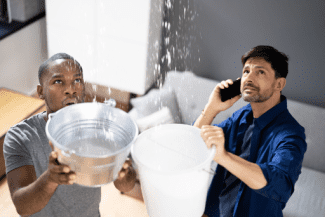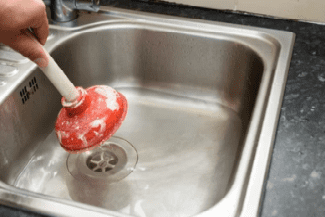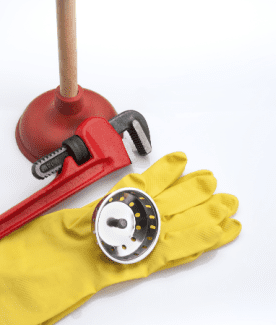Plumbing emergencies: 7 Things that can go wrong—and how to solve them
Key takeaways
-
Quick action on the homeowner’s part can limit damage caused by a plumbing emergency
-
Plumbers usually charge double or triple for off-hours work
-
Sewage line problems require a company that specializes in that type of work

First, stop the flow of water by closing the shut-off valve for that specific appliance. Or, shut off the water supply to the whole house at the main valve, located where water enters the house on the ground floor.
Once you’ve stopped the flow of water, assess the damage. Do you need to call an emergency plumber? That can be pricey after hours. Or can you patch the problem yourself until an expert arrives during their normal business day?
Read on to find out the 7 most common plumbing emergencies, what causes them, how much a plumber charges to fix the problem—plus, how to handle these plumbing issues while waiting for a pro to arrive.
Common plumbing emergencies
Any problem that causes damage or affects the safety of people in your household is an emergency. For example, flooding can ruin furniture and carpeting. If you don’t stop the flow of water, serious structural damage, such as warped hardwood floors and soggy drywall, can result.
Most of these scenarios need a plumber’s attention, so don’t hesitate to call. Whether you need one after-hours will depend on the severity of the problem and how confident you are about handling the situation. A good plumber will coach you over the phone on how to minimize damage, to avoid off-hours charges.
Before making a call, it’s important to understand how plumbers charge for their services.
-
House calls during business hours: between $50–200 per hour.
-
After-hours emergencies: usually double or triple their standard hourly fees.
-
Extra service charges: Rather than doubling the usual fee, some plumbers tack on a $150–300 service fee to their standard hourly rate for off-hours calls.
The following are a few common plumbing problems listed in order of severity and what to do about them.
Plumbing emergency #1: Burst pipe
While doing the dishes after dinner, you may be surprised by water suddenly spraying out of the faucet base. Or, you might hear—not see—water gushing, only to later discover a burst pipe behind the wall spreading water across the ceiling, walls, and floor.
What to do first: Close the shut-off valve nearest to the faulty pipe. For a pipe that feeds a kitchen faucet, look under the sink where the water pipe enters the sink cabinet. If you can’t find the valve, or there isn’t one, you may have to close the main water valve to your house. If you can’t find those valves or turn off the water, call a plumber immediately to prevent further damage.
Next steps: Were you able to shut off the water? If so, you can wait for normal business hours to call a plumber and deal with the small inconvenience of not being able to use one bathroom or the kitchen for an evening.
What else you can do: Depending on the cause of the problem, you could install clamp-like patches to stop the leak until a plumber arrives. Also, if you know a pipe is frozen, try using a hair dryer on a low setting to melt the ice.
What caused the problem: There are several reasons why pipes spring leaks.
-
Rusted pipes. When two different pipe materials join together, such as copper and galvanized steel, the steel pipe can rust and eventually leak. Sometimes it’s a serious leak, but other times, only small pinholes develop in the pipe.
-
Frozen pipes. Frozen water expands, which can cause a pipe to rupture. Prevent frozen pipes by using insulation around the pipe, installing a frost-proof faucet, and blocking drafty crawl spaces.
What it costs to fix: If the problem is caused by rusty pipes, there are inexpensive fittings a plumber can apply to separate the two pipe materials. They cost about $25 for parts and another $100–300 for 1-2 hours of labor.
If part of the pipe needs to be replaced with new copper tubing, it’ll cost $350–1,700 at normal rates. Price depends on the length of replacement pipe required and complexity of installation.
Plumbing emergency #2: Leaky water heater
If you’ve noticed a puddle around the base of your water heater, the bad news is that it’s probably leaking and might need to be replaced. After all, the average water heater lasts about 15 years.
What to do first: Close the shut-off valve where the cold water pipe enters the water heater, to stop the flow of water. You can also connect a garden hose to the valve at the bottom of the tank, to siphon water in the tank to a drain or outdoors.
Next steps: Call a plumber to inspect your water heater before it causes considerable damage to the area around it.
Sweetwater Plumbing in Apex, North Carolina was able to install a new water heater STAT for HeatherJon M. “My 17-year-old water heater died and overflowed this morning,” they write. “Less than 3 hours from my call, we have a new tank installed! Wow!”
What else you can do: If there is standing water, remove it using a shop vac. Then place fans in the area to dry the floor. You can rent high-power fans for this purpose from your local home and garden store. It’s also helpful to install dehumidifiers in the area.
What caused the problem: Sediment and minerals in the water can eventually damage the lining of the tank, causing the internal tank to start leaking. If that’s the case, the unit will need to be replaced. Sometimes only the drain valve is leaking, which is less expensive to replace.
What it costs to fix: A drain valve replacement will run about $200–300. A full water heater replacement can cost between $800–1,500. Expect to pay double for emergency repairs or installations.
Paying Too Much For Insurance?
Get a FREE quote to insure your rental properties for less.
Plumbing emergency #3: Sewer backups
There are few words more dreadful than “sewer backup,” but you can prevent this situation from getting out of hand if it’s happening to you. You’ll know if it’s a sewer backup because the sinks and toilets on the lowest level of the house will contain sewage and won’t drain.
What to do first: It’s important to shut off all running water during a sewer backup—don’t turn on faucets, flush a toilet, or run the washing machine or dishwasher. “If you stop running water, [sewage] won’t back up into your house,” says Jared Kaercher of The Drain Doctors in Camp Hill, Pennsylvania.
Next steps: Call a plumber if backup happens during regular business hours. If it’s the middle of the night, you can wait for regular hours to have it fixed—provided that no one will be using water during that time.
What caused the problem: Typically, a blockage, such as tree roots piercing through the house’s main drainline, causes sewer system backups. In extreme cases, sewage will back up into plumbing fixtures like toilets, floor drains, and sinks on the lowest level of the house. You are responsible for repairs to the drainline that runs from your house out to the street where it meets the municipal sewer line.
What it costs to fix: You’ll have to find a plumber who can snake out a sewer drain, which will cost about $175–450 during business hours. You’ll need a company that specializes in drain repair and replacement because not all plumbers will do this type of work.
Plumbing emergency #4: Sump pump failures
If you’ve just been through a storm and notice that your basement is flooded, a sump pump failure might be to blame. Sump pumps remove water from areas of your home that are below ground, like a basement, which can be prone to flooding during heavy rains.
What to do first: If your basement flooded, first remove the water in the “sump pit” where the pump is located, so that a plumber can access it. Use a bucket to bail out the sump pit, or a submersible pump to extract the water.
Next steps: Call a plumbing expert to assess the cause of the failure. Kim G. from Eugene, Oregon, had a sump pump problem that was handled with minimal stress by Petersen Plumbing. “Sadly our pump was dead, but they were able to replace it in the same visit, and the price was very reasonable. I appreciated the customer service and their ability to resolve the issue in a timely manner.”
What caused the problem: There are a few reasons sump pumps stop working:
-
Clogs. A clog can occur in the screen at the bottom of the pump. A plumber can clear the screen to get the pump working.
-
Motor burnout. If the motor dies, the sump pump must be replaced.
-
Power failure. Pumps can conk out if your home loses power during a storm. Consider getting one with a battery backup.
What it costs to fix: Repairs will run $300–800. For example, cleaning a clogged sump pump screen costs approximately $300–500. A new sump pump replacement will cost quite a bit more at $700–1,800. Off-hours repairs can double the price.
Plumbing emergency #5: Clogged drains
Pretty much everyone has encountered a clogged drain at one time or another. You might be in the midst of getting ready for work, but your shower basin won’t empty, putting a kink in your morning routine. Thankfully, clogged drains are more of an annoyance than a disaster.

Next steps: Fortunately, you can fix many clogs yourself. A plunger can often dislodge the clogs. If you can remove the protective screen on tub and shower drains, you may be able to fish out clumps of hair and soap scum with a wire clothes hanger, or a drain-clearing tool sold at your local hardware store.
Severe clogs will need the attention of a plumber who’ll use a drain snake to punch through the clog. In some cases, the plumber may have to disassemble some drain piping to get at the blockage.
What causes the problem: Kitchen clogs are usually caused by food particles and grease. Most bathroom drain clogs result from a buildup of hair, soap scum, and makeup.
What it costs to fix: Expect to pay $125–300 for a plumber to clear a drain during normal business hours.
Plumbing emergency #6: Clogged toilet
Although not fun to deal with, clogged toilets don’t necessarily spell catastrophe if you deal with them promptly. The good news: typically you can handle a clogged toilet without the help of a pro.
What to do first: If water has risen to the rim of the bowl, don’t flush again, which can cause the water to overflow. If the bowl is already overflowing, stop the flow of water by closing the toilet shut-off valve. It’s usually located behind the base of the toilet—you’ll see a knob—turn it until water stops flowing.
Next steps: If the toilet bowl is filled with water, use a bucket to remove a few inches, or allow some of the water to drain before attempting to unclog it with a plunger. Then, place the mouth of the plunger over the hole in the toilet and give it a few pushes until the clog is dislodged.
If your plunging attempt is unsuccessful, you’ll have to call in a plumber who’ll use a closet auger (also known as a closet snake) to remove the clog.
If there’s another toilet in the house, wait for normal business hours to call a plumber. If it’s the only one, you may want to hire a pro as soon as possible.
What caused the problem: Toilets have built-in traps that are designed to hold water and prevent sewer gas from entering the home. If your toilet is clogged, usually it’s because too much toilet paper or waste is blocking the trap.
What it costs to fix: Expect to pay $150–300, plus an extra service charge for off-hours work.
Plumbing emergency #7: Running toilet
If you hear a constant flow of water coming from your toilet—even hours after the last flush— chances are it’s running. Toilets are considered to be “running” when water from the tank flows into the toilet bowl, and the toilet bowl empties continuously without stopping.
What to do first: While running toilets don’t usually cause immediate damage, they do waste water and have the potential to cause long-term problems, so they should be handled as soon as possible. You can often stop the running by jiggling the toilet handle, which you’ll have to remember to do each time that you flush the toilet.
Next steps: You may be able to fix a running toilet yourself with a kit from your local hardware store. If the DIY fix doesn’t work, call a plumber. Sometimes a running toilet can lead to other problems such as a septic system failure if it isn’t addressed promptly.
Jody A. from Columbus, Ohio says, “We had a toilet that was constantly running and getting clogged. Mike [from McDermott Plumbing] gave us some options and pricing up front. He also gave us some prevention tips for the future.”
What caused the problem: Usually the flapper, which blocks the fill tube to the toilet bowl, is worn out and no longer seals properly.
What does it cost to fix: A DIY replacement flapper might cost under $10, while calling a plumber to resolve a larger problem will cost $100–300 during normal hours.
Flooding risks
There are a number of plumbing emergencies that can cause extensive flood damage to your home if the water isn’t stopped and cleaned up immediately. They include:
-
Water heater leaks
-
Sewer backups
-
Sump pump failures
-
Burst pipes
Water can easily damage fabrics, wood, carpeting, and drywall, which may have to be discarded. In some cases, repairing the damage caused by the flood will be more expensive than repairing the cause of the flood. The affected areas must be dried out thoroughly and promptly (within 24 hours) so they don’t breed mold.
You may need a flood mitigation company to remove the water and dry out the space to prevent mold from growing. Or you may be able to handle some of the clean up yourself, if you have the right tools. Keep in mind that surfaces will require a thorough cleaning and sanitizing.
Dos and don’ts for handling plumbing problems
Prepare for future emergencies by following these simple steps.

Basic plumbing tools to keep on hand:
Plunger
Drain snakes (toilet and sink drain)
Rubber gloves
Rubber boots for flooded spaces
Tools for minor repairs: wrenches, slip-joint pliers, pipe-sealing tape
Have a clean-up plan in place. Remove standing water with a shop vac, if possible. After sewer backups, clean and disinfect the area once standing water is gone.
Stay calm. Water gushing from a burst pipe or a leaking water heater is stressful. Once you’ve stopped the flow of the water, you can wait for the plumber to fix the problem.
Don’t do the following:
-
Forget to wear rubber boots when walking through standing water
-
Enter any rooms with standing water and electricity because the water may have an electrical current that can cause electrocution, serious injuries, or even death
-
Attempt to make a repair you’ve never tried before
-
Disregard the directions on the water heater for restarting the unit
How to find a good plumber
Do your research now and save the contact information for a few good plumbers in your phone so you’re not scrambling to find an expert in an emergency.
Start by searching for plumbers in your area on Yelp. Reviews can help you find a plumber who’s reliable and won’t overcharge for their services. Also, don’t hesitate to ask for recommendations from family and friends, as well as other tradespeople you’ve worked with.
Call a few of your finalists to ask specific questions about their fee structure and how they would handle common plumbing problems that you might encounter in your home.
A plumber who will take the time to answer your questions is a good sign, as Michael C. from Randolph, New Jersey found when dealing with Ryan and Company. “He was cordial [and] very knowledgeable and shared his diagnosis without making me feel like a dummy. We would wholeheartedly use them for any future issues.”
Some questions to ask a plumber include:
-
Are you licensed and insured? Most states require plumbers to have these basic requirements.
-
Can you provide references? A reputable plumber will be happy to supply this; make sure to contact the references.
-
Do you make emergency visits? Not all plumbers do.
-
Do you charge for a service call? Most plumbers will charge you a fee, usually under $100, for coming to your house to give an estimate or to determine if they can do the work. Usually, the charge is waived if they get the job.
-
If I have a problem, can I call you to get advice over the phone? A good plumber will give you direction on how to contain a plumbing emergency until they arrive.
-
Can you give me a written estimate for a job I have in mind? Plumbers should visit your house and provide a written estimate before beginning a job. Be wary of any plumber that promises a price over the phone without seeing the job site.
-
If my job needs a permit will you get it? Major plumbing projects, such as replacing a gas water heater or rerouting a drain line, require a permit. Professionals know the permitting process, so it is best if they do the paperwork.
Source: Yelp















 Accessibility
Accessibility